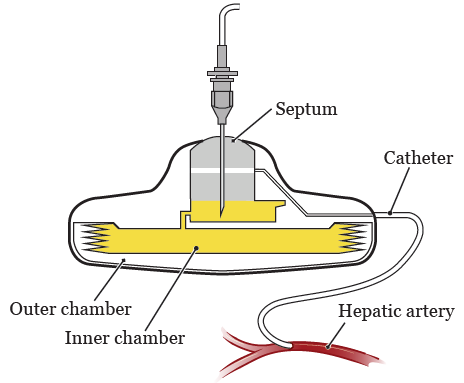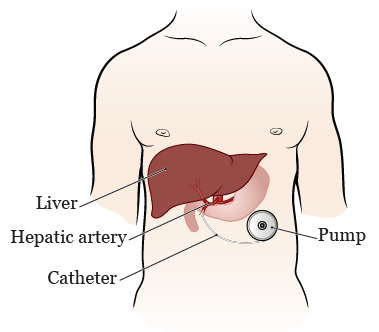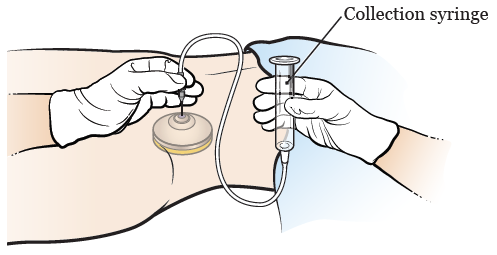This information describes your Intera 3000 hepatic artery infusion pump (previously called the Codman pump), including how it works, how it’s placed, how it’s refilled, and activity guidelines.
About Your Intera 3000 Pump
You will get your medication through a Intera 3000 hepatic artery pump. Your hepatic artery pump is a small, round device made of titanium metal. It’s about 2 or 3 inches wide, about 1 inch thick, and weighs about 4 ounces. It’s about the same size as a hockey puck.
Your hepatic artery pump has 4 main parts (see Figure 1).

Figure 1. Parts of your pump
- The septum is a raised area in the center of your pump. Your medication will be put into your pump through the septum.
- The inner chamber holds your medication.
- The outer chamber holds a liquid called a propellant.
- The catheter is a small, flexible tube. It connects your pump to your hepatic artery (the main blood vessel that goes into your liver).
Your hepatic artery pump will be implanted (surgically placed) in your abdomen (belly) close to your liver (see Figure 2). When the propellant is warmed by your body, it will cause the medication to flow out of the inner chamber, through the catheter, and directly into your liver through your hepatic artery.

Figure 2. Where your pump will be placed
Medication can be given by your hepatic artery pump in 2 ways:
- The medication can be given at the same rate all the time. This is how it’s usually given.
- The medication can be given with a single injection (shot) called a bolus. With the bolus method, the medication isn’t stored in the inner chamber of your pump.
How Your Pump Is Implanted
You will have a surgery to implant your hepatic artery pump. Your nurse will give you more information about your surgery and tell you how to get ready for your surgery.
You will be given general anesthesia (medication to make you sleep) before your surgery starts. Once you’re asleep, your healthcare provider will make a small incision (surgical cut) in your lower abdomen. They will make a space between the skin and muscle and place your hepatic artery pump in this space. Then, they will place your pump’s catheter into your hepatic artery.
Your surgery will take about 1½ to 2 hours. If you’re having other procedures done as well, it might take longer. After your surgery, you will stay in the hospital for 1 to 3 days, unless your healthcare provider tells you otherwise.
Your doctor or inpatient nurse will give you an identification card that says you have an implanted device. You must carry this card at all times while you have your pump, both in the hospital and at home.
About Your Flow Scan
Before you start using your hepatic artery pump, you will have a procedure called a flow scan to make sure your pump is working properly. The flow scan will be done after your pump is implanted, while you’re staying in the hospital. Your nurse will give you more information about this procedure before it’s done.
After your flow scan, your nurse will fill your pump with medication. Your nurse will give you information about your medication and its possible side effects.
After your pump is placed, you will have a higher risk of getting stomach ulcers (sores in the lining of your stomach). This is because the catheter is close to your stomach and might irritate it. Your nurse will give you medications during treatment to help keep this from happening.
Activity Guidelines While You Have Your Pump
It usually takes about 4 weeks to recover after the surgery to place your hepatic artery pump. After you recover from your surgery, you can go back to doing most of your usual activities. But, there are some activities you should avoid. Follow the guidelines below. Talk with your healthcare provider if you have any questions.
- Avoid rough physical activities (such as contact sports). They can cause an injury to your pump site.
- Avoid lifting objects heavier than 10 pounds (4.5 kilograms). This can make your pump move out of place.
- Avoid strenuous exercise (such as running or jogging). It can make the catheter move out of place.
- Check with your healthcare provider before you travel by airplane. Pressure changes in the cabin can cause your medication to flow faster.
- Avoid deep sea or scuba diving. You can swim or snorkel.
-
Avoid activities that can raise your body temperature. They can make your medication flow faster. Do not:
- Place heating pads, electric blankets, or hot water bottles directly on your pump site.
- Go in a sauna or hot tub.
Refilling Your Pump
Your hepatic artery pump will only hold enough medication for 14 days (2 weeks). It must be refilled on the 14th day. It’s very important that you go to all of your refill appointments. Your pump can run dry if it isn’t refilled regularly. If that happens, it will become blocked by blood clots and damaged.
- Call your healthcare provider if you can’t go to a refill appointment.
- Tell your healthcare provider if you will be out of town at any point while you have your pump.
You can come to MSK or visit your local provider to have your pump refilled.
When you aren’t getting medication, your pump will be filled with glycerol. Glycerol is a thick solution that lets you go 6 weeks between pump refills.
How your pump is refilled
The procedure to refill your hepatic artery pump will take 10 to 15 minutes.
First, your nurse will clean your skin over your pump. They will put a needle that’s attached to a thin tube through your skin, into the septum (see Figure 3). The prick of the needle might be uncomfortable.

Figure 3. Needle, tube, and syringe
Your nurse will use a syringe to take out and measure any medication left in your pump. This won’t be uncomfortable. Once your pump is empty, your nurse will refill your pump with medication. You won’t have any discomfort while the medication is being refilled.
Call Your Healthcare Provider if You:
- Have a fever of 100.4 °F (38 °C) or higher.
- Have any signs of infection at your pump site, such as tenderness, drainage, or redness.
- Have swelling over your pump site.
- Have plans to travel by airplane.
- Are going to miss a scheduled refill appointment.
- Have dark colored urine (pee) or jaundice (yellowing of your eyes or skin).
- Have any unexplained or unusual reactions.
